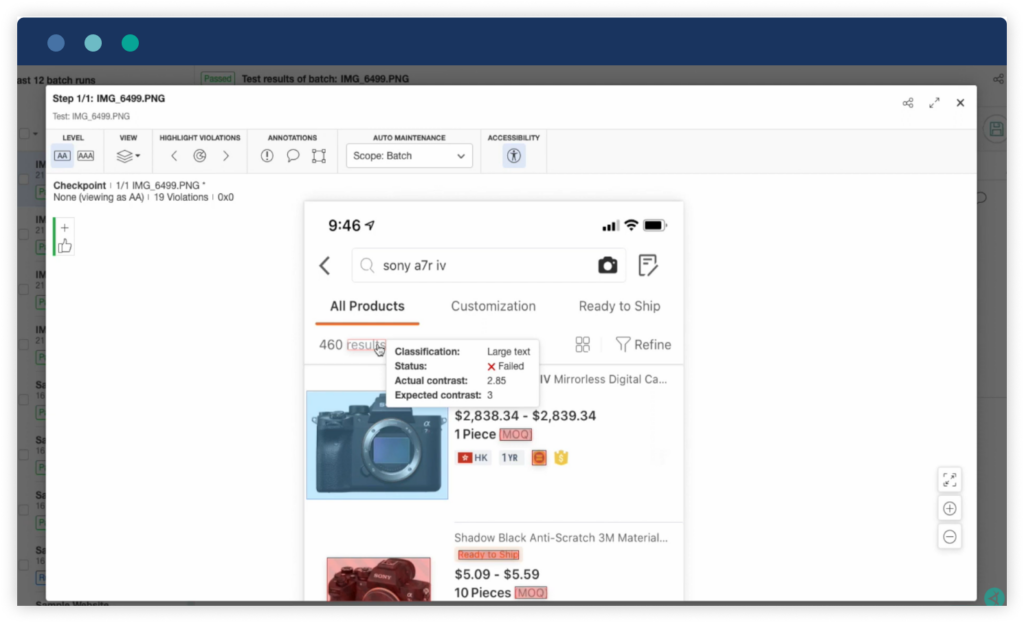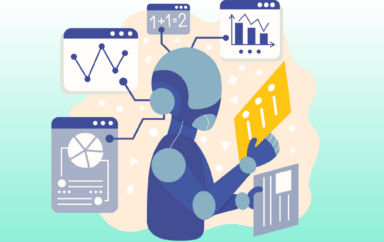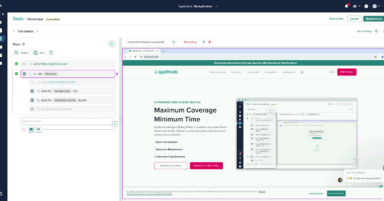Modern ecommerce applications are more than digital storefronts. They’re immersive, complex experiences designed to captivate and engage customers—customers that spent well over $1 trillion in 2024 (over $220 billion during seasonal shopping surges).
Ecommerce applications are now multifaceted ecosystems that require high reliability, fast updates, and seamless performance across devices. With features like multi-step checkout, dynamic promotions, and personalized recommendations, these applications present a unique challenge for testing teams: ensuring consistent quality in an environment of constant change.
From adaptive content testing to streamlined cross-platform validations, AI-powered testing helps software test and development teams deliver personalized, high-quality experiences to their shoppers.
Step 1: Addressing the Core Challenges in Ecommerce Application Testing
To understand how AI-powered testing can enhance quality, we first need to think about the primary complexities in ecommerce applications:
- Dynamic Content
Promotions, recommendations, and A/B testing create a dynamic landscape where content changes rapidly, which can lead to issues in test reliability. - Multifaceted User Journeys
A typical user flow can include browsing, filtering products, adding items to a cart, and various checkout steps, each with variations like promotional codes and payment methods. - Cross-Platform Consistency
Ensuring a consistent experience across mobile, desktop, and tablet adds another layer of complexity, requiring cross-device and cross-browser validations to prevent regressions.
These challenges make e-commerce application testing labor-intensive, especially for teams relying on traditional methods–manual or automated.
Step 2: Leveraging AI to Manage Complexity in Ecommerce Testing
Let’s explore how AI-powered testing can help address the common pain points of ecommerce application testing:
Autonomous Testing for Comprehensive Flow Coverage
Autonomous testing provides broad page coverage by automatically creating visual tests for each page from a single URL. For more complex, critical user journeys, custom flow tests blend human oversight with AI assistance to ensure thorough validation.
AI tools, like Applitools Autonomous, can learn the structure of complex user journeys—like multi-step checkouts or specific promo code applications—and adapt to new scenarios with minimal manual intervention. For developers, this means reduced time writing scripts and a faster feedback loop, as the AI detects critical paths and validates user interactions autonomously.
Test Tip: Use autonomous testing to cover frequently changing paths like checkout, where many variations (promo codes, payment methods) need to be validated with each update.
Visual AI for Dynamic Content Testing
AI-powered visual testing focuses on meaningful changes, helping to identify only the differences that impact user experience. Traditional test automation often flags minor layout shifts that don’t affect usability, leading to unnecessary noise. On the other hand, Visual AI detects layout issues that matter, minimizing false positives and simplifying testing for high-variance content.
Use Cases: Visual AI is particularly effective in handling promotional banners, personalized ads, and product recommendations. It ensures that these elements render correctly without producing redundant alerts.
Cross-Browser and Cross-Device Testing
Ensuring consistency across devices and browsers is crucial in ecommerce. Testing with a tool, teams can validate both functionality and appearance across multiple environments in parallel, enabling broader test coverage with significantly reduced runtime.
Tool Tip: For each release, use the Ultrafast Grid to run tests across all targeted browsers and devices simultaneously. By testing in parallel, you can catch visual and functional discrepancies early, ensuring consistent experiences across your audience’s preferred devices.
AI for Personalized and Edge Case Testing
AI-powered testing can adapt to personalized and localized content variations. This allows you to verify account-based and user-specific scenarios, like tailored recommendations, language translation, and geolocation-based offers. The AI dynamically generates test scenarios for real-world edge cases, validating content presentation, accuracy, and functionality across users.
A/B Testing and Experimentation
AI testing tools can run tests alongside A/B experiments to quickly validate different scenarios and identify potential issues without extensive setup or downtime. Integrated into CI/CD pipelines, AI can seamlessly support experimentation, allowing you to test new features or changes with agility.
Test Tip: Use AI for A/B testing by validating that both variations display correctly and function as expected. This can streamline experiment verification and minimize risk.
Accessibility Compliance with AI
Accessibility is key to ensuring inclusivity for all of your shoppers when you consider that 4.4% of the world’s population is colorblind. Even more shoppers have contrast sensitivity issues (we don’t know about you but some of us are just getting old). AI-driven testing identifies accessibility issues early, such as missing alt text, improper color contrast, and navigation difficulties. With accessibility testing integrated into automated pipelines, developers can confidently meet compliance requirements while optimizing the experience for users with disabilities.

Step 3: Applying AI Testing in Real-World Ecommerce Scenarios
Ensuring that every scenario receives accurate validation across all paths and user types can be hard but your team can quickly improve test coverage by integrating AI into the below scenarios:
- Multi-Path Checkout Testing
AI testing tools validate complex checkout flows, including various payment methods, promo codes, and cart adjustments. This reduces the risk of abandoned carts due to broken checkout paths and ensures seamless user experiences. - Product Filtering and Sorting
Filtering and sorting are essential for user navigation. AI testing validates the functionality and accuracy of filters by testing different combinations. This ensures the results match user criteria and display correctly. - Personalized Content Validation
Personalized recommendations, banners, and product listings are critical for user engagement. AI-powered testing verifies that these elements display correctly based on user data, ensuring consistency without disrupting the layout.

Step 4: Getting Started with AI-Powered Testing
To maximize the benefits of AI in ecommerce application testing, you can follow these best practices:
- Integrate AI into your CI/CD Pipeline
Embedding AI testing into the CI/CD process ensures that every change undergoes rigorous testing before reaching production. This allows for fast iteration and high-quality releases. - Prioritize Dynamic and High-Risk Areas
Focus AI testing on paths that involve dynamic content, personalized features, and checkout flows. These areas tend to have the highest variance and the most critical impact on user experience. - Leverage Parallel Testing
Run cross-platform tests in parallel to streamline testing cycles and get immediate insights into how changes impact various devices and browsers. - Use AI for Regression and Smoke Tests
Routine regression and smoke testing can become resource-intensive. By automating these with AI, you free up resources for more complex testing, ensuring each release is stable.
To Wrap Up…
As AI becomes an integral part of the testing process you can shift your focus toward building new features and enhancing shopper experiences by maintaining a high standard of quality:
- Reduced Manual Work and Faster Releases
By automating repetitive tasks and handling edge cases, AI-powered testing allows QA teams to focus on high-impact scenarios, reducing time to market. - Increased Test Coverage and Accuracy
AI’s ability to adapt to dynamic content and complex scenarios broadens test coverage and increases the accuracy of results, ultimately reducing production issues. - Adaptability to Ongoing Changes
AI-powered testing lets ecommerce sites handle constant updates and seasonal changes without extensive reconfiguration so that shoppers have a seamless experience.
AI-powered testing is now an essential strategy for ecommerce test and dev teams to meet user expectations and stay competitive. You can try out these strategic steps with a free trial of Applitools Autonomous.
Quick Answers
AI-powered testing uses artificial intelligence to automate and streamline the testing process for ecommerce applications. It helps by reducing manual work, increasing test coverage, and enabling faster releases, ensuring a high-quality user experience across complex, dynamic platforms.
AI testing tools, like Visual AI, detect meaningful changes in content rather than minor layout shifts. This approach reduces false positives and focuses on changes that impact user experience, making it ideal for handling elements like promotional banners and personalized recommendations.
Ecommerce customers use a range of devices, so cross-platform testing ensures a consistent experience across mobile, desktop, and tablets. AI testing enables parallel testing across these environments, catching visual and functional issues early in the development cycle.
AI-powered tools validate various scenarios within checkout flows, such as payment options and promo codes. By automating these tests, teams can quickly ensure that all variations work seamlessly, reducing the risk of issues that could lead to cart abandonment.
AI adapts to personalized user experiences by validating content specific to each user, such as recommendations or location-based offers. This ensures that tailored elements render correctly and are consistent across different users and sessions.
Accessibility is essential for inclusivity, ensuring that all users, including those with disabilities, can interact with the site. AI testing tools identify issues like low contrast, missing alt text, and navigation problems early, helping teams meet compliance standards and enhance the experience for all users.




